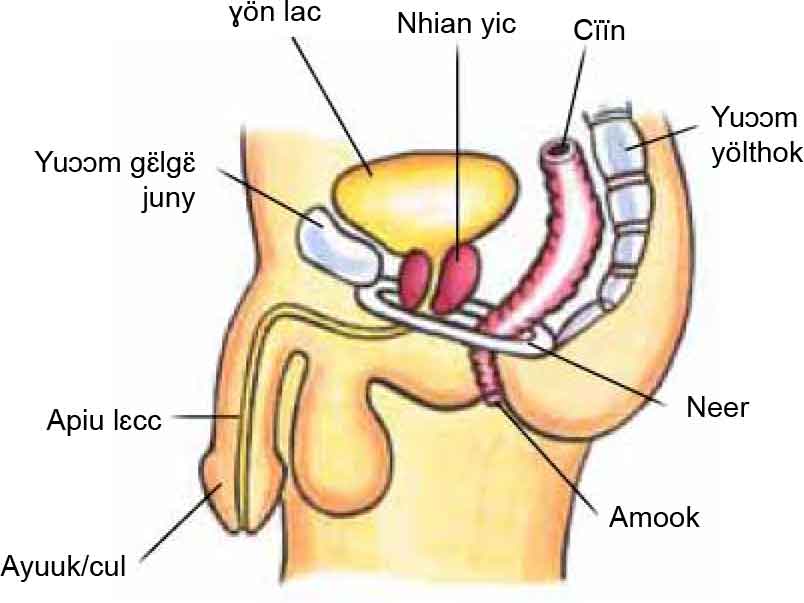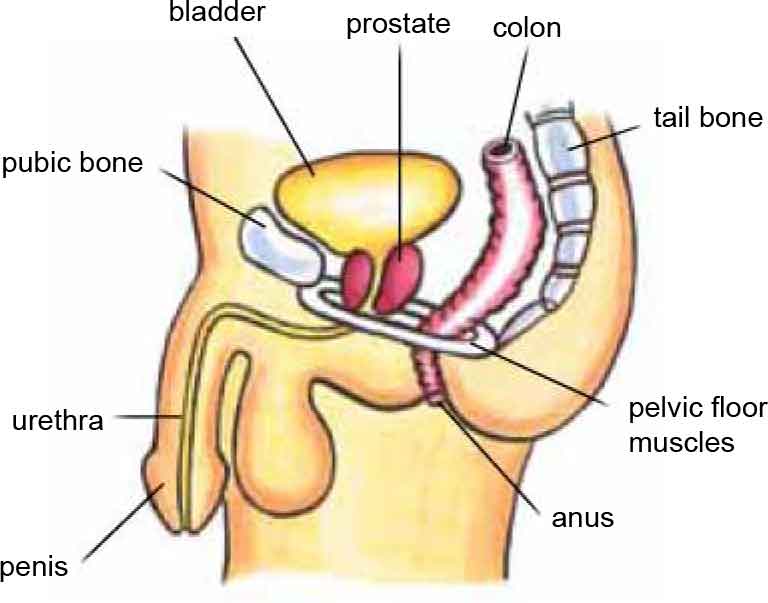What are the pelvic floor muscles?The floor of the pelvis is made up of layers of muscle and other tissues. These layers stretch like a hammock from the tailbone at the back, to the pubic bone in front. A man’s pelvic floor muscles support his bladder and bowel (colon). The urine tube and the back passage pass through the pelvic floor muscles. Your pelvic floor muscles help you to control your bladder and bowel. They also help sexual function. It is vital to keep your pelvic floor muscles strong. |
Acuek aŋuum ye käŋö?Aŋuum a leŋ yic acuek kuc juëc. Acuek kä cë riɛ̈ɛ̈u raan aŋuum gɔl tueŋ ɣet ciëën cëmën awar cë thiɛt ɣöt yic. Acuek aŋum ë moc aa yäc ku alɛ̈ɛ̈c duööt nhial. Dhël la roor ku dhël lɛc aa tëëk acuek aŋuum yic. Acuek aŋuum kä kek aa yï kony ba la roor ku laac ya muk nhïïm bë käŋ cï ye wat path. Keek aya aa raan kony toot. Apath ba acuek kuun aŋuum ŋiɛc ya muk nhïïm bïk cï lär. |
|
|
 |
Why should i do pelvic floor muscle training?Men of all ages need to have strong pelvic floor muscles. Pelvic floor muscles can be made weaker by:
Men with stress incontinence – that is, men who wet themselves when they cough, sneeze or are active – will find pelvic floor muscle training can help in getting over this problem. Pelvic floor muscle training may also be of use for men who have an urgent need to pass urine more often (called urge incontinence). Men who have problems with bowel control might find pelvic floor muscle training can help the muscle that closes the back passage. This muscle is one of the pelvic floor muscles. |
Yeŋö dhil ɣɛn räl ciëën acuek duääny?Rööl wɛ̈ɛ̈c ruön ken yiic aa dhil laŋ acuek aŋuum ril tör. Käkä aa lëu bïk räl acuek cɔl a lär nyïn:
Rööl cï acuek aŋuum cïn lär – rööl röt läc tɛ̈ ɣɔɔl kek, tïïm kek wälä tɛ̈ tuuk kek – aa bë laŋ tɛ̈thi kek acuek aŋuum ku tɛkdä ka bë ŋiɛc ya gum tɛ̈ këc ror dööt.> Duɛ̈ɛ̈ny acuek aŋuum aya a lëu bë röör kony laac (bïk cï ye kööl kaam bär yic ke tït lac). Röör rɛc yääc ken aa lëu bïk laŋ tɛ̈thi tɛ̈ duɛ̈ɛ̈ny kek acuek aŋuum rin bïk ror cï ye dääk. Acuek wën raan cɔl agum tɛ̈ wïc yen la roor aa nuɛ̈t kek acuek aŋuum ebën. |
Where are my pelvic floor muscles?The first thing to do is to find out which muscles you need to train.
If you don’t feel a distinct “squeeze and lift” of your pelvic floor muscles, or if you can’t slow your stream of urine as talked about in Point 3, or you do not see any lift of your scrotum and penis as talked about in Point 4, ask for help from your doctor, physiotherapist, or continence nurse. They will help you to get your pelvic floor muscles working right. Men with very weak pelvic floor muscles can benefit from pelvic floor muscle training. |
Acuek ciëën aŋuum tɔ̈ukä tɛ̈no?Kë ba kaŋ looi ee ba ŋic ye acuek nɛn kek wïc duɛ̈ɛ̈ny.
Na cïn tɛ̈ ye yök, wälä cïn tɛ̈ ye yïn lɛc teem kɔɔth tɛ̈ mën wën cï ye lueel abaŋ diäkic, wälä cuöl du ku nhian ku aa cï ye tïŋ ke jɔt röt ku kɛɛckä cëmën wën cï ye lueel abaŋ ŋuanic, ka yï la tɛn akiɛm du, raan duun yï duääny wälä akuɔnyakïm ë thiu thar. Keek kɔɔc kä aa lëu bïk yï kony ba acuek kuun aŋuum cɔk piny. Röör cï acuek aŋuum nyïn lär aa lëu bïk tɛthi yök tɛ̈ duɛɛny kek acuek keen aŋuum. |
How do I do pelvic floor muscle training?Now that you can feel the muscles working, you can:
While doing pelvic floor muscle training:
|
Ba acuek aŋuum duääny kadä?Mën cïn acuek kuun aŋuum jal ŋic tɛ̈ ye kek luui thïn, yïn a lëu:
Ka yï duɛ̈ɛ̈ny acuek aŋuum:
|
Do your pelvic floor muscle training wellFewer good squeezes are better than a lot of half hearted ones! If you are not sure that you are doing the squeezes right, or if you do not see a change in symptoms after 3 months, ask for help from your doctor, physiotherapist, or continence nurse. |
Ye acuek aŋuum ŋiɛc duäänyNa ye acuek aŋuum ŋiɛc rot ku jɔt keek arak lik yiic ka cë cït tɛ̈ yïn ye looi arak juääc ku a cï ye ŋiɛc looi! Na kuc lɔn yïn acuek aŋuum ŋiɛc rot ku jɔt keek wälä na cïn kë cë rot waar pɛy ka diäk yiic, ka yï cɔl rot a kony akiɛm du, raan duun yï duääny wälä akuɔnyakïm ë thiu thar. |
Make the training part of your daily lifeOnce you have learnt how to do pelvic floor muscle squeezes, you should do them. Every day is best. You should give each set your full focus. Make a regular time to do your pelvic floor muscle squeezes. This might be after going to the toilet, when having a drink, or when lying in bed. Other things you can do to help your pelvic floor muscles:
|
Loi duɛ̈ɛ̈ny kën bë ya kë duun ye looi abakNa ca rut ku jön acuek aŋuum ŋic, ka path ba ya looi abak. Na ye looi abak ka path apɛy. Ye yï puöu tääu thïn tɛ̈ looi yïn yeen. Lɔc kaam bïn acuek aŋuum ya duääny. Tɛkdä ka lëu ba ya looi kuat tɛ̈ cïn la roor, tɛ̈ dëk yïn, wälä tɛ̈ cïn yï kɔ̈u tääc agerem nhom. Kä kɔ̈k lëu ba looi ba acuek aŋuum cɔl a ril:
|
Seek helpQualified nurses are available if you call the National Continence Helpline on 1800 33 00 66* (Monday to Friday, between 8.00am to 8.00pm Australian Eastern Standard Time) for free:
If you have difficulty speaking or understanding English you can access the Helpline through the free Telephone Interpreter Service on 13 14 50. The phone will be answered in English, so please name the language you speak and wait on the phone. You will be connected to an interpreter who speaks your language. Tell the interpreter you wish to call the National Continence Helpline on 1800 33 00 66. Wait on the phone to be connected and the interpreter will assist you to speak with a continence nurse advisor. All calls are confidential. * Calls from mobile telephones are charged at applicable rates. |
Wïc kuɔɔnyMathaat akïm cï piöc aabï tɔ̈ na yï ayup telepun Kuɔɔny Baai käk thiu thar ee nïmra kënëic tök, bɛ̈t, gueu, diäk, diäk, gueu, dhetem, dhetem*/ 1800 33 00 66* (aköl Tök agut aköl Dhiëc ee Läätic (Monday- Friday) kaam thaa bɛ̈t nhiäk-duur (8am) ku thaa bɛ̈t thëëi (8pm) ee thaa kɔc Australia ciëŋ Ciëën) aye gäm kɔc abɛc:
Na yïn acie ŋiëc jam thoŋ English apiɛth ka yïn alëu ba telpun luɔi ye kɔc Kuɔny wɛ̈r thokic yuɔ̈p. Cɔl nïmra kënë tök diäk, tök, ŋuan, dhiëc/13 14 50. Tueŋic, abï raan kɔŋ dhuk nhom ee thoŋ English, luel thoŋduɔ̈n ee yïn jam ku tiɛ̈ɛ̈t ee telepunic. Yïn abï tuɔ̈ɔ̈m thok kek raan kɔc waar thook/duwër jam thuɔŋdu, ku jal kek lɛ̈k wɛ̈tduɔ̈n wïc ee yïn kɔc Baai Kuɔɔny Käk thiu thar yuɔ̈p ee nïmra kënëic tök, bɛ̈t, gueu, diäk, diäk, gueu, dhetem, dhetem/ 1800 33 00 66. Tiɛ̈ɛ̈t ee telepunic ku bï yï gam ku duwër abï kony ba jam kek mathaat akïm kɔc lɛ̈k. Telepun duwër aye kɔc yup thïn abɛc/majan ee rin cïn en wëu ye wïc tënë yïn. Kek wël ëbɛ̈n aye thiaan yiic. * Yup mobaalic ee wëu cam tëcït cɔ̈t baai ëtɛ̈n. |
Pelvic Floor Muscle Training for Men in Dinka
Duɛ̈ɛ̈ny Räl Acuek Tɛ̈n Rööl
Browse and download our factsheets in Dinka
Last Updated: Fri 30, Jul 2021
Last Reviewed: Tue 17, Mar 2020


